Strategi trading Triple Screen
Pendahuluan
Para trader pemula kerap mencari sebuah alat magis — indikator yang dapat membantu mereka dalam menghasilkan profit besar. Untuk sesaat, mereka mungkin mendapatkan keberuntungan itu, tapi tidak lama kemudian magis tersebut sirna. Saat mengalami kerugian, mereka cenderung berpikir bahwa penyebabnya adalah indikator yang kurang andal. Sehingga mereka pun mencari yang lain, tapi hal yang sama terulang.
Tentu saja ini adalah pendekatan yang keliru jika melihat pemahaman yang salah tentang karakteristik dari masing-masing indikator. Tak satu pun dari mereka didesain supaya menciptakan interpretasi atau prediksi yang sempurna terhadap pasar. Di samping itu, tak satu pun dari mereka dirancang agar berkorelasi dengan indikator-indikator lainnya. Justru sebaliknya, indikator-indikator tersebut dianjurkan untuk diterapkan dalam sebuah kombinasi, sekalipun situasi yang satu sama lain kontradiktif.
Alexander Elder adalah seorang trader ternama, terkenal karena telah menerbitkan berbagai macam buku panduan tentang strategi trading. Dia memperkenalkan sebuah pendekatan yang disebut "triple screen". Pendekatan ini menggabungkan berbagai indikator dan memfilter kelemahannya sembari mempertahankan kekuatannya. Secara singkat, strategi ini memberi pendekatan tiga tingkatan untuk membuat keputusan trading. Silakan perhatikan.
Umum
Pertama, Anda menentukan timeframe yang ingin Anda gunakan. Apa pun pilihan Anda, Anda tetap akan memiliki dua timeframe lagi untuk dimonitor dalam kaitannya dengan pilihan pertama tadi: timeframe yang lebih besar menggambarkan keadaan pasar secara lebih luas, sedangkan yang lebih rendah memberikan pandangan rinci tentang situasi yang tengah berkembang dan memberi kesempatan kepada Anda untuk memilih titik entry yang tepat.
Sebagai contoh, jika Anda ingin trading intraday, Anda bisa memilih grafik H1 sebagai bidang utama untuk pengamatan Anda, H4 untuk memonitor keadaan pasar secara lebih luas dan M15 untuk spesifikasi titik entry. Masing-masing timeframe akan terlihat pada salah satu dari tiga layar, seperti pada tabel di bawah ini.
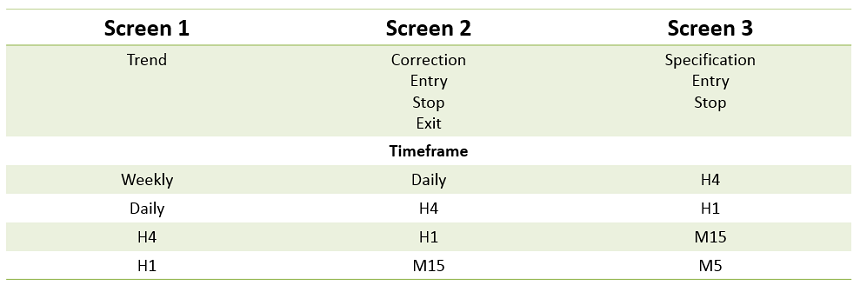
Layar pertama
Misalnya kita ingin melakukan beberapa transaksi dengan Platinum. Kita membuka tiga grafik, yaitu H4, H1, M15. Pada grafik H4, kita mengamati adanya penurunan harga dan pergerakan ke area koreksi. Berdasarkan situasi ini, kita berasumsi harga akan naik untuk sesaat (saat koreksi). Oleh karena itu, kita memutuskan untuk melakukan aksi beli dan menjual ketika harga mencapai level yang lebih tinggi. Sekarang, kita membutuhkan verifikasi atas pengamatan kita tadi dan mengujinya dengan indikator-indikator yang lain. Untuk itu, kita perlu membuka menu indikator dan menyertakan MACD dan Stochastic Oscillator (caranya bisa dilihat pada gambar di bawah ini).
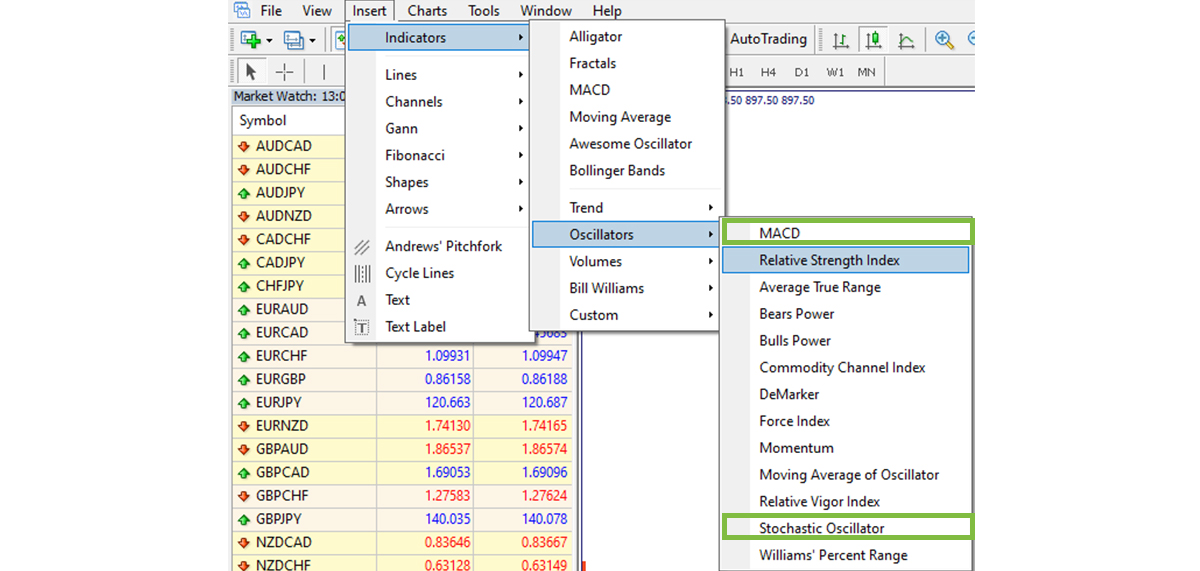
Kita mengamati bahwa MACD telah menyentuh low ekstrem di bawah garis sinyal (area yang dipilih pada gambar di bawah). Sedangkan indikator Stochastic menunjukkan bahwa garis cepat (garis solid) memotong garis lambat (garis putus-putus) dari bawah ke atas dalam zona 0-20%. Keduanya biasanya dianggap sebagai pertanda bahwa pasar sedang berada dalam kondisi jenuh jual dan mensinyalir aksi beli. Dengan demikian, sekarang kita mempunyai konfirmasi dari dua indikator bahwa pembacaan kita mengenai pasar kemungkinan besar adalah benar dan strategi kita berpeluang besar memetik hasil positif. Selanjutnya, mari kita lihat layar kedua.
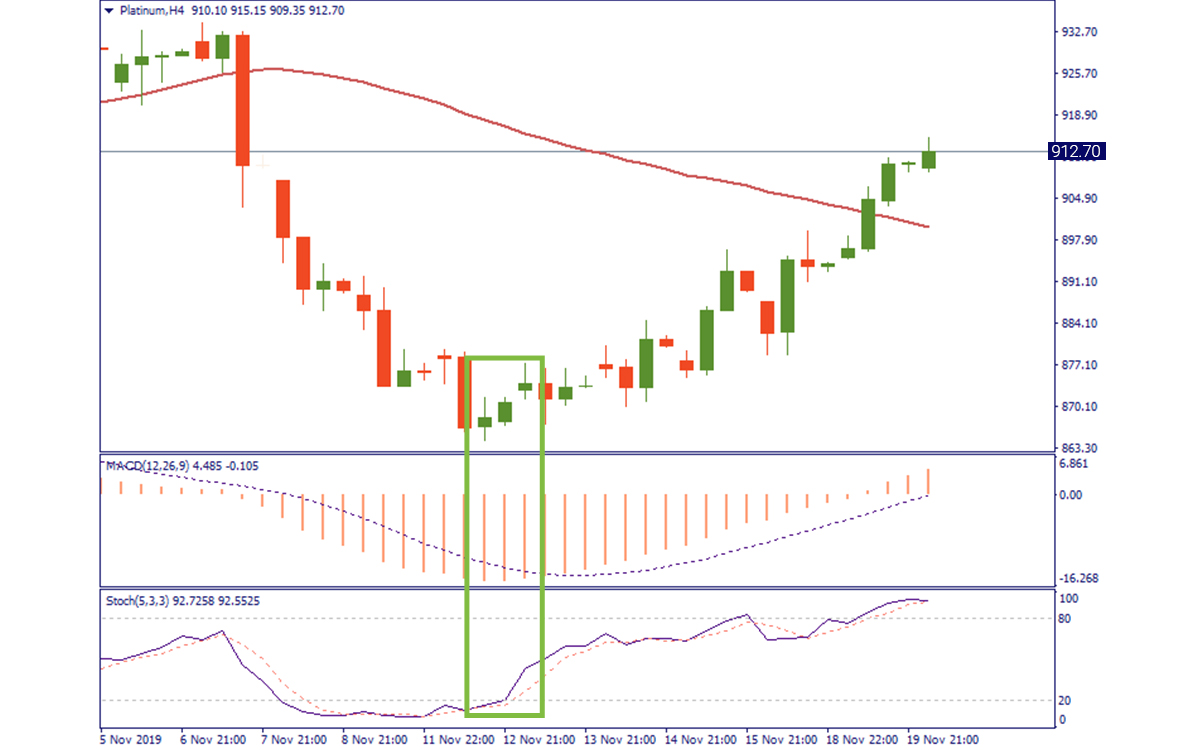
Layar kedua
Layar kedua berfungsi untuk mengonfirmasi ulang pengamatan yang dilakukan pada layar pertama dan untuk menunjukkan area entry yang lebih tepat. Untuk itu, kita perlu menambahkan RSI ke jendela grafik. Cara memilihnya bisa dilihat pada gambar di bawah ini.
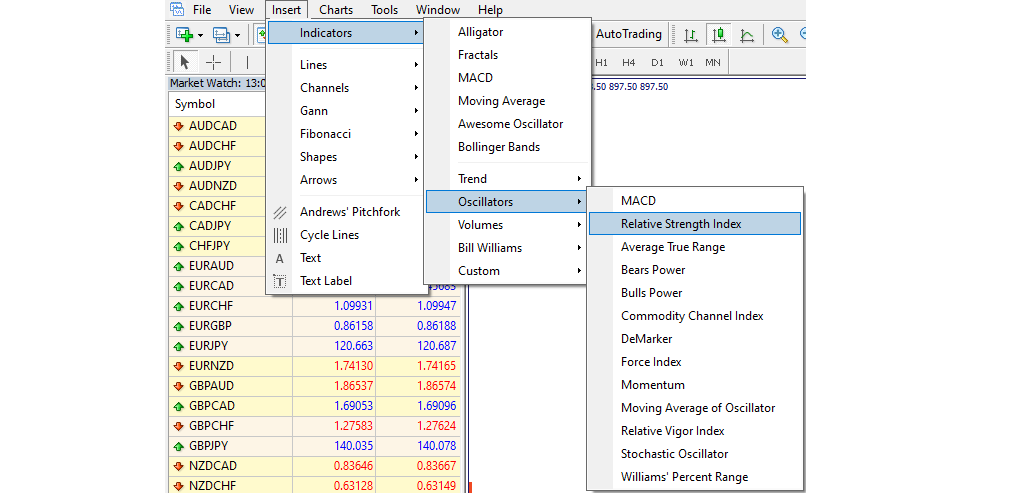
RSI merupakan indikator yang bagus, menyajikan indikasi kekuatan pasar yang cukup akurat beserta momen pembukaan posisi yang aman. Mengingat kita ingin melakukan aksi beli pada tren naik saat koreksi, kita akan mencoba untuk menangkap momen untuk membuka posisi beli. RSI memotong 30%, persis saat itu juga. Pada grafik H1 Platinum, kita melihat bahwa ia memotong level jenuh jual. Dengan demikian, kita mendapat gambaran bahwa dorongan bullish pasar ternyata cukup kuat. Hal ini menjadi pengujian kedua untuk strategi kita. Maka dari itu, kita melanjutkannya ke layar ketiga untuk memilih level pembukaan posisi beli.

Layar ketiga
Layar ketiga tidak membutuhkan indikator apa pun. Pada grafik M15, kita mengamati secara detail gelombang yang mengidentifikasi area entry pada grafik sebelumnya. Kini kita hanya memerlukan konfirmasi ulang bahwa sekarang pembalikan arah ke bawah tidak akan terjadi, karena dikhawatirkan dapat menggagalkan hipotesis kita terhadap pasar. Kita menunggu harga naik hingga di atas level yang ditunjukkan bersama dengan Moving Average berperiode 50. Ini adalah sinyal bagi kita untuk membeli. Kita dapat membuka posisi beli tepat setelah candlestick pertama tutup di atas garis resistance, dan memasang stop loss di bawah penurunan candlestick sebelumnya.
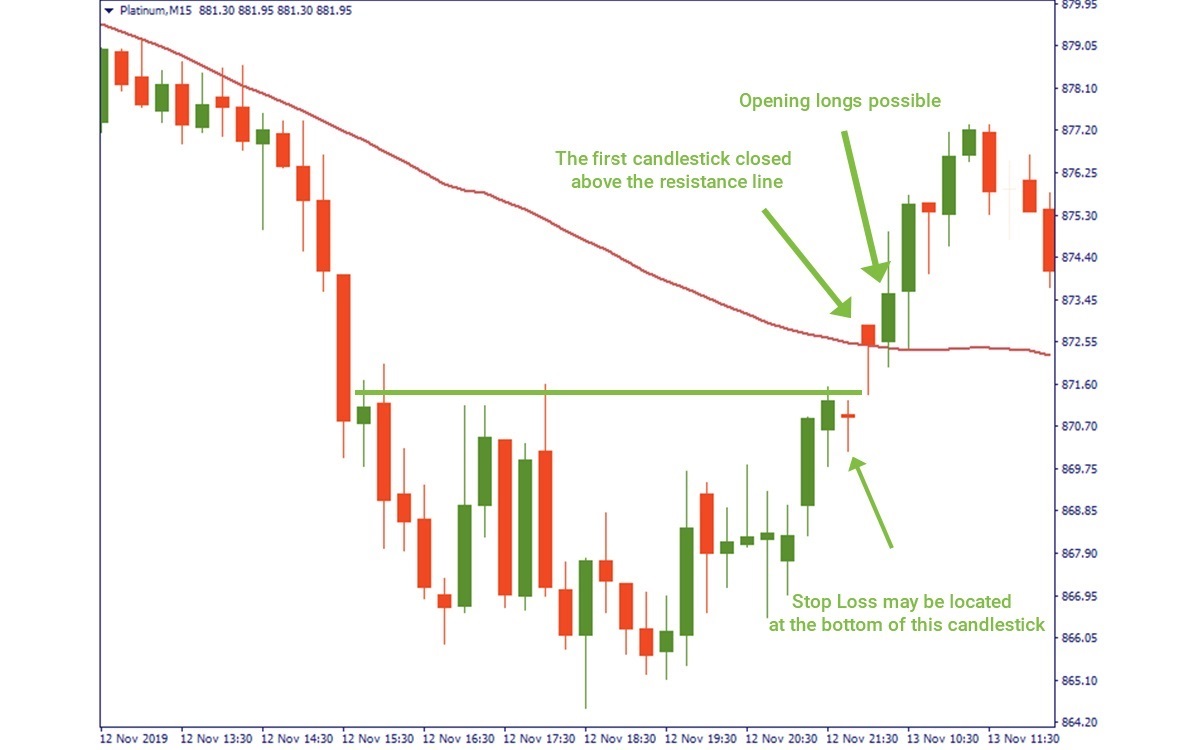
Kesimpulan
Contoh pengamatan ini memberi gambaran strategi untuk tren naik lokal yang diikuti dengan tren turun secara global. Jadi, kita mencoba untuk "mengarungi gelombang": di pasar yang sedang turun, kita membeli di level low dan menjual di level high dari setiap tingkatan. Skenario yang berlawanan ditujukan untuk pasar yang sedang naik.
Pertanyaan selanjutnya, bagaimana jika harga berperilaku menyimpang dari yang kita prediksikan? Jawabannya adalah tidak ada metodologi trading yang sempurna. Penyempurnaan dari pendekatan ini merupakan tugas dari masing-masing trader yang ingin menemukan situasi tertentu di mana kondisi tersebut berlaku. Atau, trader harus memahami pada skenario mana strategi trading tidak dapat diterapkan. Gagasan strategi ini sebenarnya sederhana: lakukan filtrasi selama proses pengambilan keputusan dan gunakan beberapa indikator saat melakukan trading.
Baca lebih lanjut
- Strategi trading Three Ducks
- 3 strategi teratas yang dapat dikuasai oleh pemula
- Strategi trading untuk timeframe jangka pendek
- Strategi trading dengan Bollinger Bands
- Strategi trading ‘HHLL’: cukup ikuti pergerakan harga
- Strategi trading untuk pola Head and Shoulders
- Strategi Trading: Three Wise Men dan Alligator
- Strategi trading dengan dead cat bounce
- Strategi Scalping Ultra-cepat